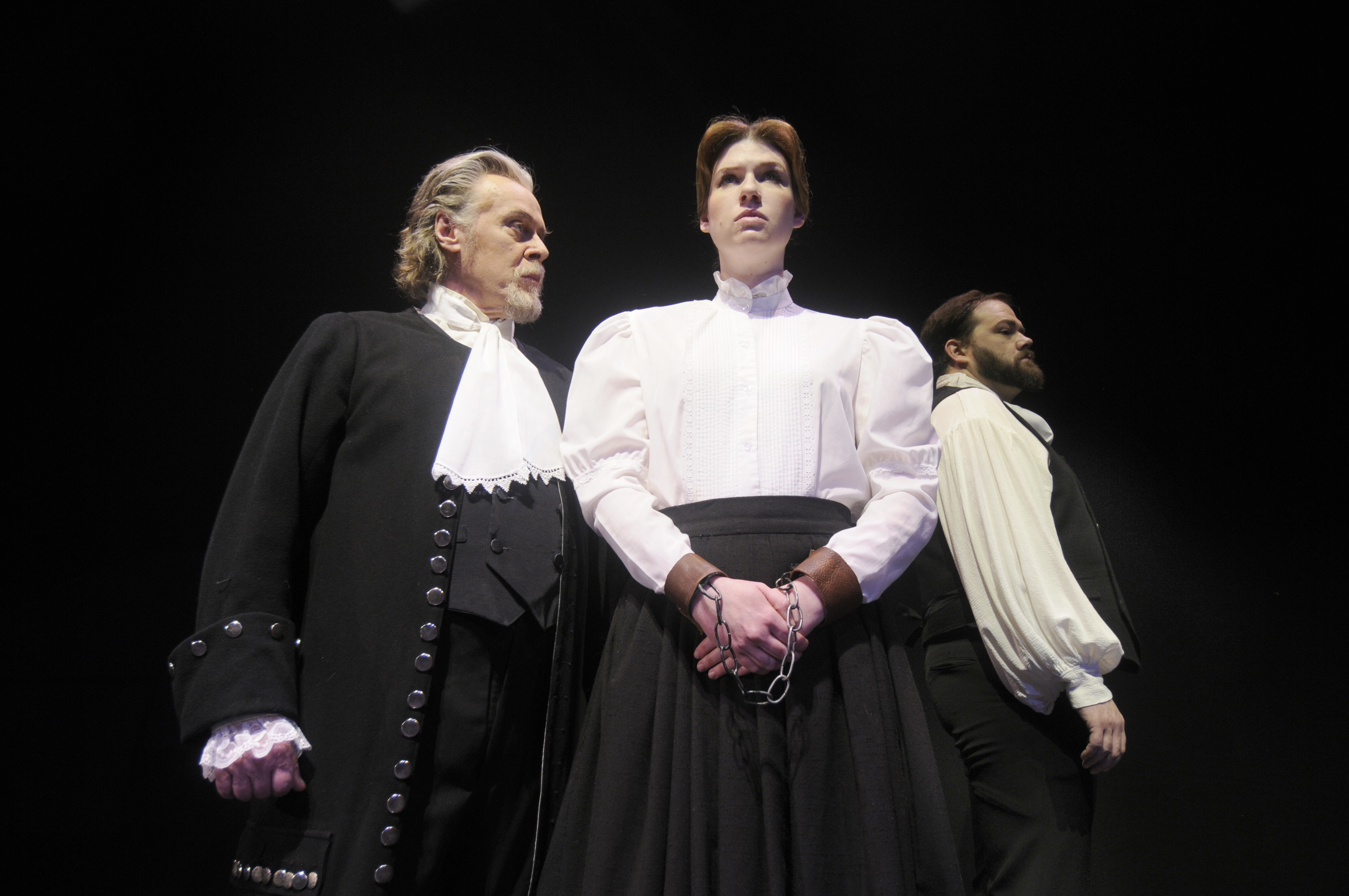SALT LAKE CITY — “I see what I see.” Arthur Miller‘s play The Crucible tells the story of what can happen when people are blinded by what they want to see, rather than what actually is. The story begins in 1692 in the small town of Salem, Massachusetts—population 600. Based on true events, the opening scene takes the viewers right to the beginning moments of what most of us will hear about at some point in our lives, the Salem Witch Trials.
A group of young girls have been discovered dancing in the woods by firelight. Immediately fear of witchcraft is brought to surface and for reasons still unknown, the girls’ turn to fits of fainting and hysterics, claiming that they have seen the devil. Abigail Williams (Sahara Hayes) emerges as the girl who seems to be most afflicted by the “possession” and the audience soon discovers her relationship with John Proctor (David Hanson), for whom she once worked as a servant. You would think that an affair between an older man with a teenage girl would immediately make you disgusted, but the writing and personable charter that Hanson brings makes it easy to sympathize with his plight. With little time for foreshadowing, the scene quickly shifts to the Proctor home several weeks later over which a cloud of impending doom hangs for the wife of John Proctor, Elizabeth (Cassandra Stokes-Wylie). Abigail is obviously unstable and jealous of Elizabeth and accuses her of witchcraft.
As the numbers of people accused double and triple at a disturbing rate, it’s nerve wracking to watch the fear seep in and control the people of Salem. The absurdity of the hypocrisy and fallacies that the townspeople use to justify the irrational condemnation is ludicrous. As something close to methodical mob-mentality takes over the town, several hundred are accused, nearly 200 jailed and 30 people hanged or killed.
Hayes, Sheridan Underwood (as Mary Warren), and Robin E. Young (as Betty Parris) provided captivating portrayals of these disturbed young women. At times, it was nearly impossible to understand the motivations behind the recklessness in which they destroyed so many lives. In the first scene, as Young turns to screaming hysterics, the true instability of the youth is convincing. However, the green lighting (from designer Spencer Brown) choice here and throughout the rest of the production was stark, out of place, and jarring. The lighting choices using purples and reds were beautiful and haunting, but the green made it appear as if spirits possessed the young ladies.
The in the scenes between John and Abigail were especially well done. While Hayes seemed to feel a little unsure in the opening scenes, she warmed to her character and was an easy antagonist to dislike by the end of the production. Max Robinson as Judge Danforth and Jonathan McBride as Reverend Samuel Parris were the most frustrating characters for me because of their use of power and the name of God to do so much harm. However, Tyson Richard Baker as the Reverend John Hale was intriguing, as the character truly seemed to turn in on himself with guilt. The emotional and physical transformation truly portrayed his inner turmoil. I was amazed to find that Cassandra Stokes-Wylie (playing Elizabeth) was the same actor who appeared in Burn This several years back. I loved her in that show and the fact that I loved her here and had no idea who she was is a testament to her acting.
The set (Keven Myhre), consisting of nondescript houses that multiplied as the number of accusations increased, was simple and understated which allowed for a focus on the story, which lent well to this production. The only real critique I have, and it is one I often have after attending productions at The Grand, this show would have been much better suited for a more intimate theater. It was such a beautiful show and director Mark Fossen made wonderful use of the enormous stage, it felt as if some items were lost in the expansive venue.
Arthur Miller wrote this play during the McCarthy communist escapade in the 1950’s. The similarities are shocking. Nearly 350 years after the Salem Witch Trials, our nation once again persecutes and condemns based on fear. While the comparisons between Miller’s work and the events during the McCarthyism era are close, they have been criticized as too cut and dry. In the play, as well as in common thoughts that surround this event in history, the young girls are out of control and unjustly go on a crusade against this town. Leaders and those who are in positions of authority and are able to see what they want to see back this up. Yet, a weakness in the play, and perhaps the reason why the actual events are still such a topic of interest, is that the motivation behind what happened is never explored. I found it difficult to watch Abigail Williams portrayed so clearly as the “bad guy.” As in life, it is rarely that easy.
When theater is done well, it tells a believable or enjoyable story. When theater is an art, it breathes a story that is as beautiful in all aspects sound, set, lighting, direction as well as the words that the actors transform from the writer. The Crucible is one of those productions. It’s beautiful and filled with more than just the need for a story to be told.

